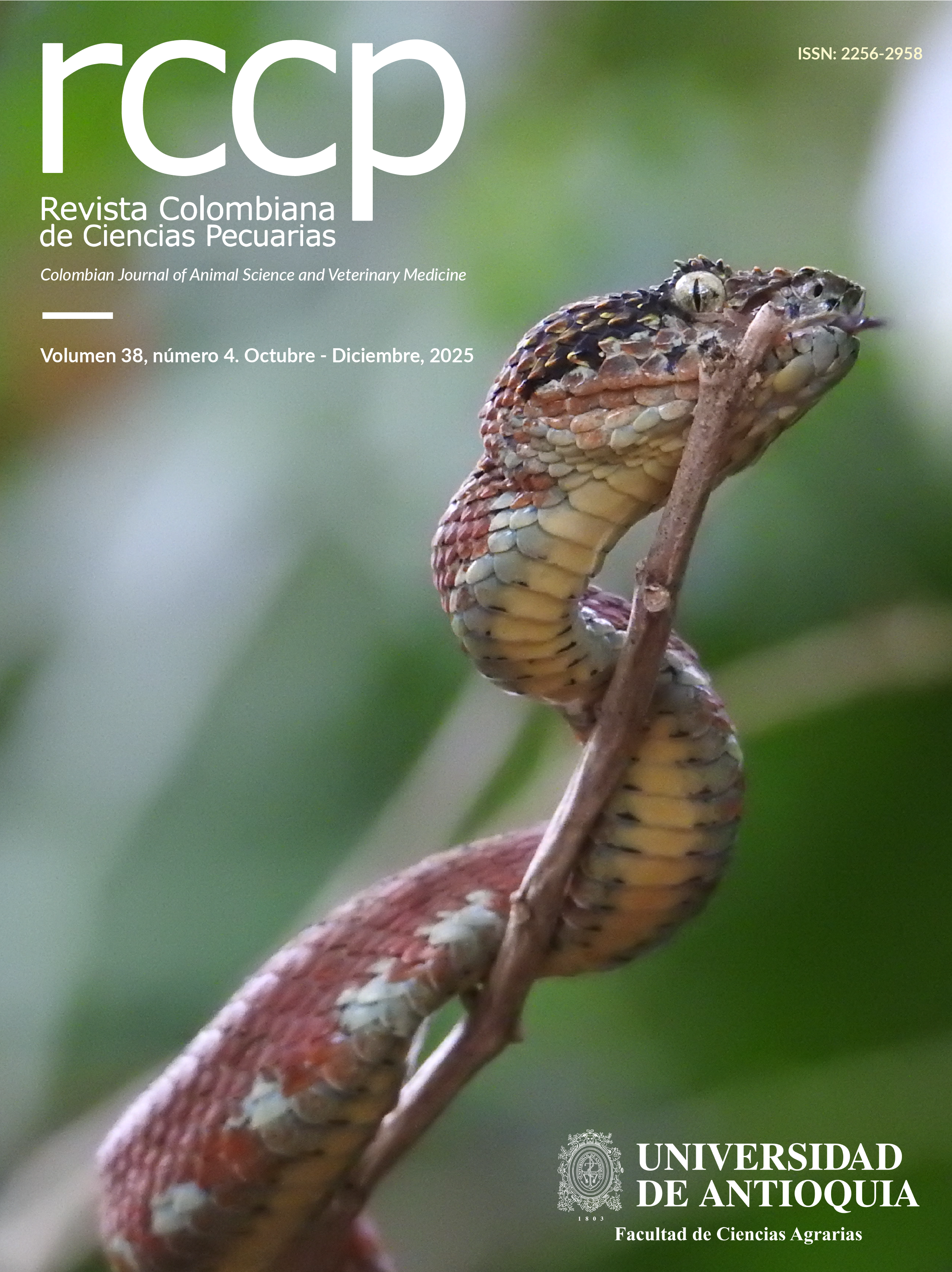Correlation between body condition and ultrasound-measured backfat in lactating Holstein cows
DOI:
https://doi.org/10.17533/udea.rccp.e358399Keywords:
body condition, cattle, cows, backfat, bovines, Holstein, lactation, lumbar, thurl, ultrasoundAbstract
Background: Ultrasonography has been developed to reduce the subjectivity inherent in body condition scoring and to provide more accurate and objective assessments. Objective: To examine the relationship between body condition score (BCS) and backfat thickness measured by ultrasound in Holstein dairy cows raised on the high plateaus of eastern Türkiye. Methods: Ultrasound measurements were obtained from two sites on the right side of the body, specifically the thurl and the lumbar regions, for a total of 112 measurements. Results: A decrease in mean backfat thicknesses was observed in both regions from the close-up period to early
lactation, followed by an increase in mid lactation. The lowest value of backfat thickness was also observed during early lactation. Overall, backfat thickness showed the same temporal trend. Pearson correlation coefficients between both regions ranged from 0.73 to 0.99, indicating a significant relationship (p < 0.01). A strong positive correlation was found between BCS and the measurements of thurl and lumbar backfat, with values of 0.79 and 0.83, respectively (p< 0.01). The linear regression coefficients between BCS and fat
thickness in the thurl, lumbar regions, as well as the average of thurl and lumbar measurements were also statistically significant (p< 0.001). Conclusion: Ultrasound measurements are a reliable and adequate method for determining the nutritional status and body energy reserves of cows across different lactation stages, given the strong correlation between BCS and ultrasound backfat thicknesss.
This method reduces the likelihood of errors inherent in visual assessment methods.
Downloads
References
Ayres H, Ferreira RM, Torres-Junior JR, Demetrio CGB, Lima CG, Baruselli PS. Validation of body condition score as a predictor of subcutaneous fat in Nelore (Bos indicus) cows. Livest Sci 2009; 123:175-179. https://doi.org/10.1016/j.livsci.2008.11.004
Bell MJ, Maak M, Sorley M, Proud R. Comparison of methods for monitoring the body condition of dairy cows. Front Sustain Food Syst 2018; 2:80. https://doi.org/10.3389/fsufs.2018.00080
Cellini M, Hussein HA, Elsayed HK, Sayed AS. The association between metabolic profile indices, clinical parameters, and ultrasound measurement of backfat thickness during the periparturient period of dairy cows. Comp Clin Path 2019; 28(3): 711-723. https://doi.org/10.1007/s00580-019-02923-0
Chay-Canul AJ, Garcia-Herrera RA, Robertos NFO, Macias-Cruz U, Vicente-Pérez R, Meza-Villalvazo VM. Relationship between body condition score and subcutaneous fat and muscle area measured by ultrasound in Pelibuey ewes. Emirates J Food Agri 2019; 53-58. https://doi.org/10.9755/ejfa.2019.v31.i1.1901
Domecq JJ, Skidmore AL, Lloyd JW, Kaneene JB. Validation of body condition scores with ultrasound measurements of subcutaneous fat of dairy cows. J Dairy Sci 1995; 78: 2308-2313. https://doi.org/10.3168/jds.S0022-0302(95)76857-6
Edmonson AJ, Lean IJ, Weaver LD, Farver T, Webster G. A Body Condition Scoring Chart for Holstein Dairy Cows. J Dairy Sci 1989; 72: 68-78. https://doi.org/10.3168/jds.S0022-0302(89)79081-0
Gillund P, Reksen O, Grohn YT, Karlberg K. Body condition related to ketosis and reproductive performance in Norwegian dairy cows. J Dairy Sci 2001; 84:1390-1396. https://doi.org/10.3168/jds.S0022-0302(01)70170-1
Hussein HA, Westphal A, Staufenbiel R. Relationship between body condition score and ultrasound measurement of backfat thickness in multiparous Holstein dairy cows at different production phases. Aust Vet J 2013; 91(5): 185-189. https://doi.org/10.1111/avj.12033
Jones GM. Body condition scores for evaluation of nutritional status. Virginia Cooperative Extension Service. Dairy Guidelines 1990; Publication:404-104.
Loeffler SH, De Vries MJ, Schukken YH, De Zeeuw AC, Dijkhuızen AA, Graaf FM, Brand A. Use of AI technician scores for body condition, uterine tone and uterine discharge in a model with disease and milk production parameters to predict pregnancy risk at first AI in holstein dairy cows. Theriogenelogy 1999; 51: 1267-1284. https://doi.org/10.1016/S0093-691X(99)00071-0
Moreira F, Risco C, Pires MFA, Ambrose JD, Drost M, Delorenzo M, Thatcher WW. Effect of body condition on reproductive efficiency of lactating dairy cows receiving a timed insemination. Theriogenology 2000; 53:1305-1309. https://doi.org/10.1016/S0093-691X(00)00274-0
Pedron O, Chell F, Senator E, Baroli D, Rızza R. Effect of body condition score at calving on performance, some blood parameters and milky fatty acit composition in dairy cows. J Dairy Sci 1993; 76: 2528-2535. https://doi.org/10.3168/jds.S0022-0302(93)77588-8
Richards MW, Spitzer JC, Werner MB. Effect of varying levels of postpartum nutrition and body condition at calving on subsequent reproductive performance in beef cattle. J Anim Sci 1986; 62:300-306. https://doi.org/10.2527/jas1986.622300x
Ruegg PL, Milton RL. Body condition scores of holstein cows on Prince Edward Island, Canada: Relationships with yield, reproductive performance, and disease. J Dairy Sci 1995; 78: 552-564. https://doi.org/10.3168/jds.S0022-0302(95)76666-8
Schröder UJ, Staufenbiel R. Invited review: Methods to determine body fat reserves in the dairy cow with special regard to ultrasonographic measurement of backfat thickness. J Dairy Sci 2006; 89(1): 1-14. https://doi.org/10.3168/jds.S0022-0302(06)72064-1
Siachos N, Oikonomou G, Panousis N, Banos G, Arsenos G, Valergakis GE. Association of body condition score with ultrasound measurements of backfat and longissimus dorsi muscle thickness in periparturient Holstein cows. Animals 2021; 11(3): 818. https://doi.org/10.3390/ani11030818
Singh R, Randhawa SNS, Randhawa CS. Body condition score and its correlation with ultrasonographic backfat thickness in transition crossbred cows. Vet World 2015; 8(3): 290. https://doi.org/10.14202/vetworld.2015.290-294
SPSS. IBM SPSS Statistics for Windows, Version 20.0, 2011. Armonk, NY, USA.
Staufenbiel R. Energie- und Fettstoffwechsel des Rindes. Untersuchungskonzept undMessung der Rückenfettdicke. Mh Vet Med 1992; 47: 467–474.
Varişli Ö. Holştayn İneklerde Suni Tohumlamada Vücut Kondisyon Skorunun fertilite ve reprodüktif parametrelere etkisi. Ankara Üniv Sağlık Bil Enst 2008. Ankara, Turkey. https://tez.yok.gov.tr/UlusalTezMerkezi/tezDetay.jsp?id=FkG2ee8uDUn_1TkpncJXJw&no=OpoJLtrLMI_jkCsl71_ziQ
Waltner SS, Mcnamara JP, Hillers, JK. Relationships of Body Condition Score to Production Variables in High Producing Holstein Dairy Cattle. J Dairy Sci 1993; 76:3410- 3419. https://doi.org/10.3168/jds.S0022-0302(93)77679-1
Zulu VC, Nakao T, Moiyoshi M, Nakada K, Sawamukai YT, Zhang WC. Relationship between body condition score and ultrasonographic measurement of subcutaneous fat in dairy cows. Asian-Aust J Anim Sci 2001; 14(6): 816-820. https://doi.org/10.5713/ajas.2001.816
Published
How to Cite
Issue
Section
License
Copyright (c) 2021 Revista Colombiana de Ciencias Pecuarias

This work is licensed under a Creative Commons Attribution-NonCommercial-ShareAlike 4.0 International License.
The authors enable RCCP to reprint the material published in it.
The journal allows the author(s) to hold the copyright without restrictions, and will allow the author(s) to retain publishing rights without restrictions.






